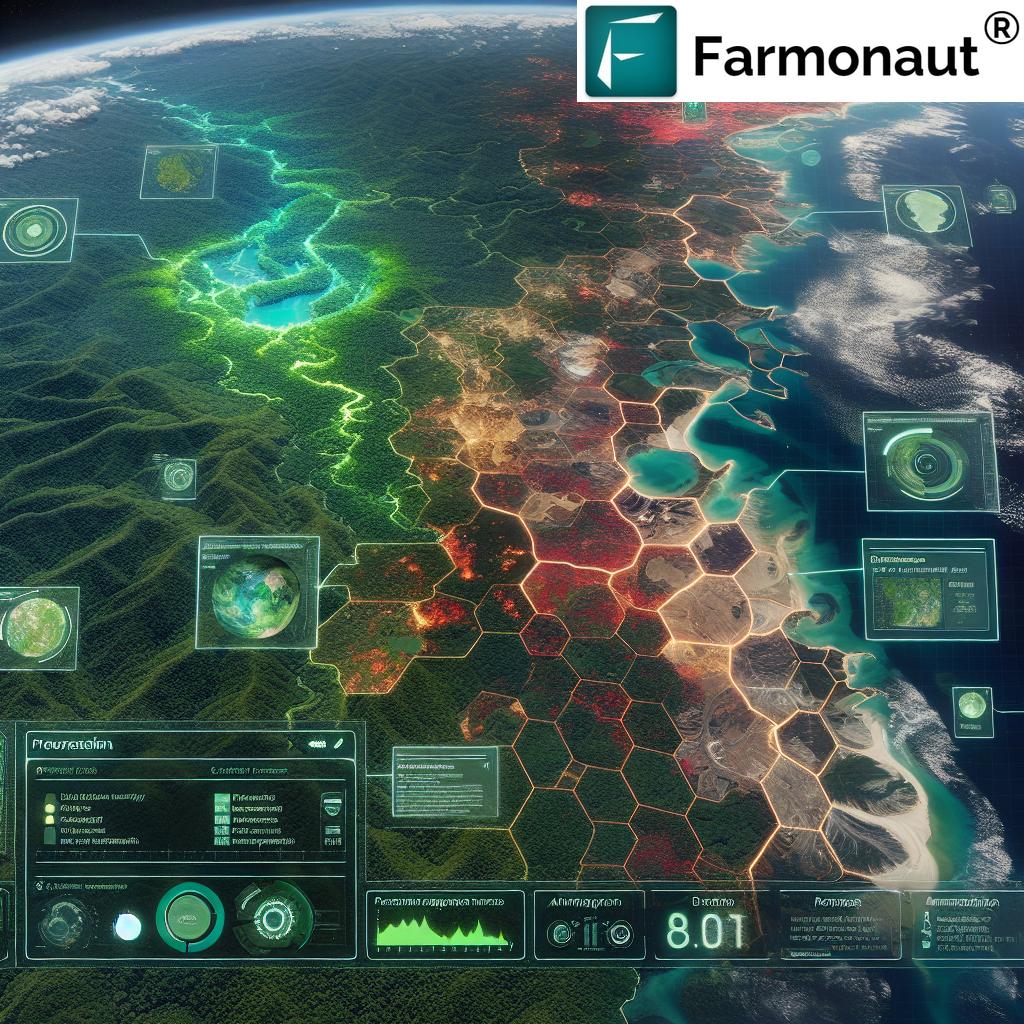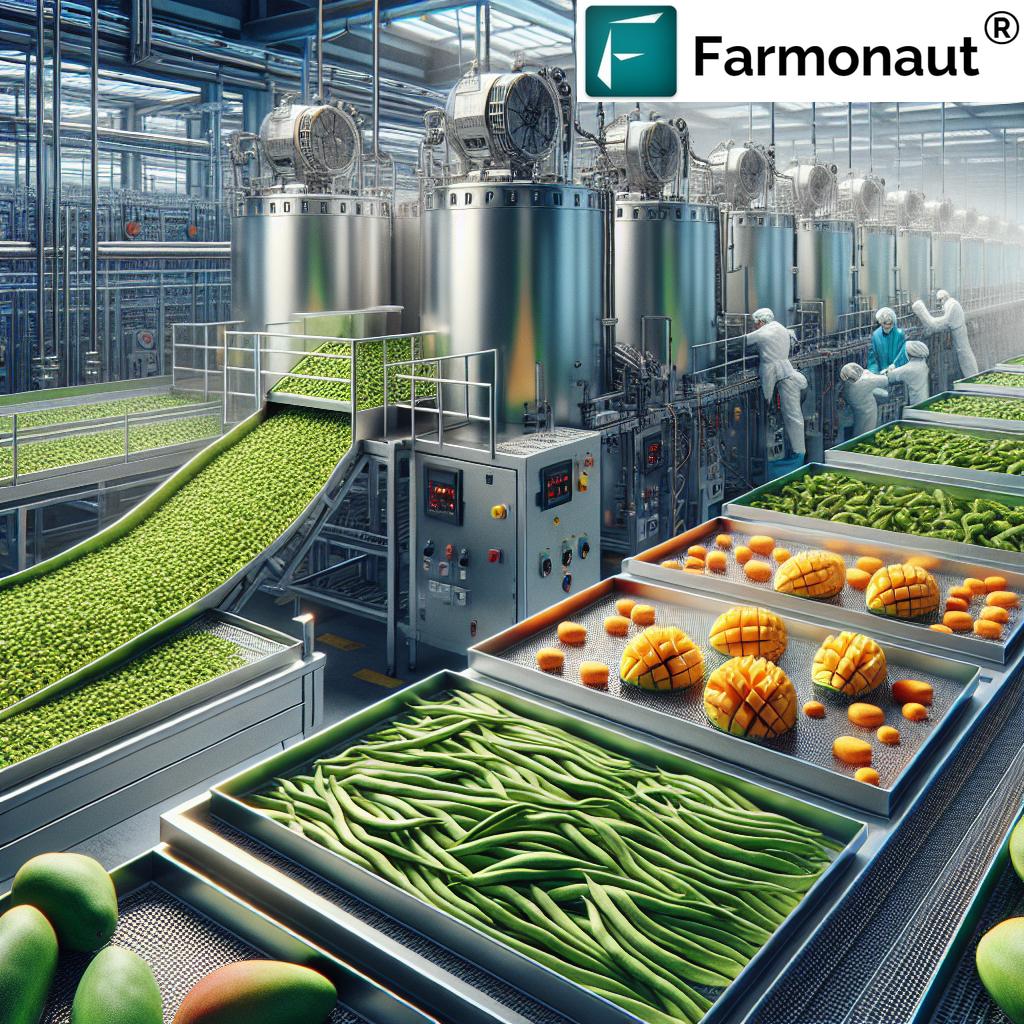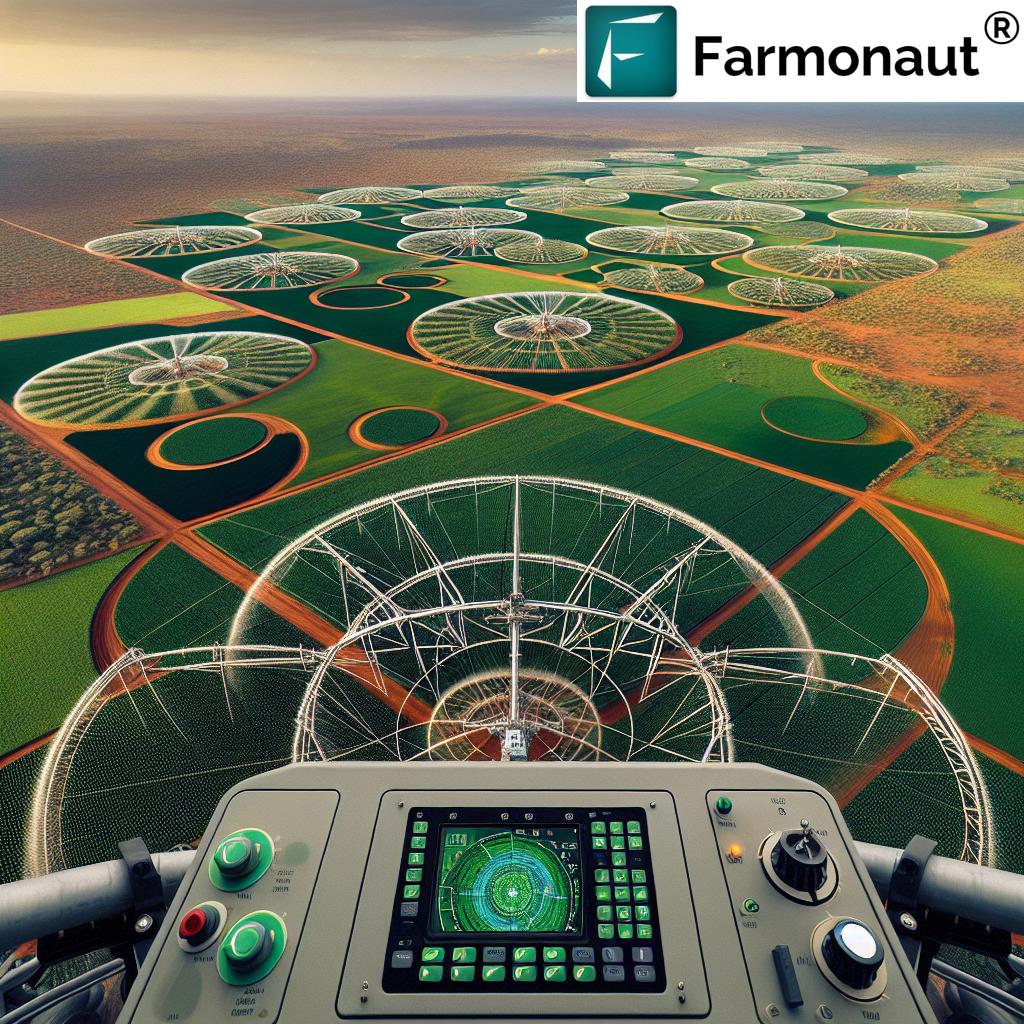Table of Contents
- Araucaria Tree, Araucaria Plant: Overview
- Botanical and Ecological Significance of Araucaria
- 7 Key Benefits of Araucaria Tree, Araucaria Plant
- Comparative Benefits Table: Araucaria Tree
- Araucaria in Sustainable Forestry & Agriculture: 2025-2026
- Araucaria Timber Value & Wood Industries
- Nut & Seed Production of Araucaria Tree, Araucaria Plant
- Araucaria Conservation: Challenges and the Future
- Farmonaut Satellite Solutions for Agroforestry & Sustainability
- FAQ: Araucaria Tree, Araucaria Plant
“A single mature Araucaria tree can absorb up to 22 kg of CO₂ annually, aiding climate change mitigation.”
Araucaria Tree, Araucaria Plant: 7 Key Benefits 2026
The araucaria tree, araucaria plant, belonging to the ancient genus Araucaria, stands as one of the most significant species in sustainable forestry and agriculture, particularly throughout the Southern Hemisphere. This majestic coniferous tree, including world-renowned species like Araucaria araucana (monkey puzzle) and Araucaria angustifolia (brazilian pine), has gained renewed attention moving into 2025 and beyond, thanks to its multifaceted role in ecology, conservation, and economic stability.
With roots tracing back to the time of dinosaurs, these ancient gymnosperms are not simply living fossils; they are a vital resource for carbon sequestration, local biodiversity support, soil health, and resilient land management—addressing many of the environmental and agricultural challenges we collectively face in the coming years. Here, let us explore the comprehensive ecological and economic importance of Araucaria trees and their expanding role in climate-smart sustainable development through 2026.
Botanical and Ecological Significance of Araucaria
The araucaria tree, araucaria plant is a member of the coniferous genus Araucaria, boasting a lineage that extends back to the Mesozoic era. Today, these evergreen trees are mainly found in Chile, Brazil, Argentina, and in certain parts of Australia and New Caledonia. Their distinctive columnar and symmetrical crown, often rising above 50 meters, lends an iconic appearance to southern landscapes, making them instantly recognizable.
Ecologically, the araucaria forests are foundational to the health of significant habitats in their native regions. The trees’ robust canopy structure helps to regulate local microclimates, reduce soil erosion on steeper slopes, and maintain soil moisture—key factors in soil conservation and sustainable agricultural practices. Moreover, these forests—hosting a diverse range of endemic and endangered species—play a critical role in conserving biodiversity and ensuring the resilience of regional ecosystems.
“Araucaria forests support over 200 unique plant and animal species, enhancing local biodiversity and ecological resilience.”
7 Key Benefits of Araucaria Tree, Araucaria Plant
The araucaria tree offers a broad array of ecological and economic benefits. In the context of forestry, agriculture, and environmental management across southern regions like Brazil and Argentina, these benefits become especially pronounced in 2026 as climate change and sustainability dominate the global conversation. Here are the seven key benefits of the araucaria tree:
- Supports Biodiversity and Provides Wildlife Habitats
- Mitigates Climate Change via Carbon Sequestration
- Improves Soil Health and Reduces Erosion
- Produces Nutritious Food (Pine Nuts) for Local Communities
- Offers High-Value Timber for Construction and Furniture
- Enhances Agroforestry and Sustainable Land Use
- Strengthens Rural Economies Through Ecotourism & Non-Timber Products
In greater detail, each benefit intersects with one or more essential pillars of sustainability: ecological preservation, economic upliftment, and climate resilience.
Comparative Benefits Table: Araucaria Tree
| Benefit Category | Estimated Impact (2026) | Relevance to Sustainability | Example Application |
|---|---|---|---|
| Biodiversity & Wildlife Habitats | 200+ unique species supported per hectare | Biodiversity Support | Endangered wildlife habitat creation |
| Carbon Sequestration | Up to 40 tons CO₂/ha/year | Climate Change Mitigation | Carbon offset projects |
| Soil Health & Erosion Control | Erosion reduced by 60% on forested slopes | Soil Preservation | Agroforestry with crops |
| Nutritious Food (Pine Nuts) | Yields up to 80 kg seeds/tree/year | Food Security | Local market food supply |
| Timber Production | Average 12-15 m³ wood/tree (mature) | Sustainable Forestry | Certified sustainable timber trade |
| Agroforestry/Sustainable Land Use | Increases crop yields by up to 30% | Sustainable Agriculture | Windbreaks, nutrient cycling |
| Rural Economy & Ecotourism | 10-15% annual revenue increase for communities | Rural Livelihoods | Ecotourism, nut harvesting, crafts |
Araucaria in Sustainable Forestry & Agriculture: 2025-2026
The role of the araucaria tree in sustainable forestry and agriculture has been transformed due to new sustainability challenges, certification schemes, and the need for resilient land management as we progress towards 2026. These species thrive in regions like Brazil, Chile, and Argentina, where both forestry management strategies and agricultural sectors are facing increasing climatic and economic pressure.
1. Supports Biodiversity and Provides Wildlife Habitats
Araucaria forests offer a critical habitat for over 200 unique plant and animal species, many of which are endemic or endangered. In southern Brazil and Chile, for example, bird species such as the Azara’s ground thrush and rare mammals depend upon mature Araucaria stands for shelter and breeding. The microclimate created by their symmetrical canopy structure helps maintain a suitable environment for ferns, mosses, orchids, and other flora, further enhancing the forest’s biodiversity value.
- Prevents species extinction in key regions by retaining unenclosed genetic pools.
- Facilitates ecosystem services like pollination and pest control for nearby agricultural lands.
2. Mitigates Climate Change via Carbon Sequestration
Araucaria trees are powerful carbon sinks. Mature trees can store up to 40 tons of CO₂ per hectare annually, with a single tree absorbing up to 22 kg yearly. This makes them an essential resource for carbon offset initiatives, environmental credits, and sustainable development programs. With climate change intensifying, increasing the coverage of Araucaria forests supports global efforts to lower atmospheric carbon concentration.
- Plays a pivotal role in forest-based carbon trading and sustainability certificates.
- Supports compliance with international climate agreements for land and forestry sectors.
For advanced and ongoing carbon monitoring, Farmonaut’s Carbon Footprinting product offers automated satellite-based insights and emissions tracking, empowering sustainable agriculture and forestry efforts.
3. Improves Soil Health and Reduces Erosion
Araucaria’s evergreen crown and widespread roots stabilize soil on hillsides and slopes, especially in erosion-prone southern highlands of Brazil and Argentina. Their annual leaf litter—rich in essential nutrients like nitrogen and phosphorus—improves soil structure while promoting beneficial microorganisms. This directly reduces the impact of heavy rainfall, lowers runoff, and supports adjacent agricultural crops.
- Acts as a living mulch, preserving topsoil moisture and structure.
- Integrates well with contour farming and shelterbelt systems.
For land managers and large-scale operation supervisors, Farmonaut’s Large-Scale Farm Management platform provides real-time soil health monitoring and precision advice to optimize land productivity and resilience.
4. Araucaria Timber Value & Wood Industries
The araucaria tree is valued for its hard, durable timber. Its wood—dense, yet easy to work with—is widely used in construction, furniture making, cabinetry, and crafts. Unlike many softwoods, Araucaria timber is resistant to decay and pests, making it highly suitable for outdoor or structural applications.
- Sustainable harvesting protocols and certification schemes now ensure that wood extraction maintains forest integrity and preserves ecosystem services.
- Countries like Brazil and Chile have embraced international certifications (FSC, PEFC) to reduce overexploitation and maintain high-quality timber as a significant economic pillar for rural communities.
To enhance timber production, utilize resource monitoring, and trace supply chains with blockchain transparency, Farmonaut’s Traceability platform guarantees the authenticity and sustainability of forest-based resources for industrial buyers and forest managers.
5. Nut & Seed Production of Araucaria Tree, Araucaria Plant
One of the major underrecognized benefits is the seed or piñon (pine nut) produced by mature trees. These seeds—an important traditional food staple in southern Chile, Brazil, and some Argentinian communities—are packed with protein, healthy fats, and minerals. As demand for superfoods and plant-based protein grows globally, the araucaria pine nut has gained renewed attention as a premium and sustainable food source.
- Seed harvesting provides income for local populations, especially among indigenous Mapuche people and small-scale farmers.
- Promotes health and nutrition security through plant-based diets.
6. Enhances Agroforestry and Sustainable Land Use
Araucaria trees are ideally suited for agroforestry systems, integrating seamlessly with crops and livestock. Their ability to provide shade, reduce wind speed, and supply organic matter improves microclimate control and land productivity. In southern Brazil, mixed stands of Araucaria, coffee, and grassland increase per-hectare revenue, reduce disease outbreaks, and lengthen the productive lifespan of farmlands.
- Agroforestry improves land efficiency by stacking multiple production streams (timber, nuts, crops) per hectare.
- Restores depleted lands, converting monocultures or degraded pasture to vibrant, diverse systems.
Real-time assessment and optimization for agroforestry projects can be carried out efficiently through Farmonaut’s Crop/Plantation & Forest Advisory Suite, designed for adaptive decision support.
7. Strengthens Rural Economies Through Ecotourism & Non-Timber Products
Eco-friendly initiatives like responsible wild nut harvesting, artisanal crafts from fallen branches and cones, and birdwatching or trekking ecotourism strengthen local economies. These non-timber resources offer a diversified income that supports rural families, especially in remote regions where other economic options are limited.
- Ecotourism based on araucaria forest biodiversity promotes environmental awareness and generates steady revenue.
- Non-timber product processing (handicrafts, foods) brings value-added opportunities to women and youth.
Araucaria Conservation: Challenges and the Future
While araucaria species deliver profound ecological and economic value, conservation faces many challenges in 2026. Over 95% of the original Araucaria angustifolia forests in Brazil have been lost to illegal logging, unsustainable land conversion, and infrastructure expansion. Deforestation leads to declining populations and genetic bottlenecks, threatening their long-term viability as both a resource and a keystone ecological presence.
However, the future is not without hope—governments, NGOs, and local communities are prioritizing reforestation programs, ex-situ conservation of rare varieties, and implementation of protected areas. Emerging technologies empower stakeholders to monitor Araucaria populations via satellite, assess ecosystem health, and forecast threats like fires, pests, and disease. Farmonaut brings these capabilities within reach, supporting effective sustainable management and biodiversity protection.
For those involved in financial planning for conservation programs, Crop loan and insurance Farmonaut’s Crop Loan & Insurance Verification can help verify restoration and sustainable agricultural efforts using satellite evidence—streamlining access to funds and incentives for restoration.
Farmonaut Satellite Solutions for Agroforestry & Sustainability
As we look toward 2026 and beyond, digital tools and AI-driven satellite monitoring have revolutionized the way we track and manage forest resources. We at Farmonaut have made it possible for landowners, farmers, ecologists, and authorities to monitor Araucaria tree health, growth, and land use changes in near real-time—all via easy-to-use mobile and web applications.
- Vegetation Health Indexing (NDVI, VARI): Enables efficient, instant detection of stressed or thriving Araucaria stands for proactive management.
- Blockchain Traceability: Delivers end-to-end transparency for timber, food, and non-timber product supply chains, fostering consumer trust and regulatory compliance.
- Resource & Fleet Management: Streamlines logistics for agriculture and mining operations; helpful in large-scale restoration projects.
- Environmental Monitoring: Tracks carbon footprint, land degradation, emissions, and ecosystem changes, supporting sustainability certifications and reporting.
To enable seamless integration, developers and organizations can use our Farmonaut Satellite Monitoring API and refer to the API Documentation for custom solutions and workflow automation.
Farmonaut Subscriptions for Forestry and Agriculture
Our flexible, subscription-based models ensure that every land manager, business, and government can access affordable, advanced satellite technology for sustainable forestry, agriculture, and conservation. Explore our latest package offerings below:
FAQ: Araucaria Tree, Araucaria Plant
- 1. What is the ecological significance of the araucaria tree, araucaria plant?
- The araucaria tree supports local biodiversity, provides shelter to endangered and endemic fauna, enhances soil regeneration, and sequesters carbon—making it a vital ecological pillar, particularly in the southern hemisphere regions like Brazil, Chile, and Argentina.
- 2. How does the araucaria tree help in climate change mitigation in 2026?
- By sequestering significant quantities of CO₂ per hectare, araucaria stands directly address the effects of climate change. Their integration in forestry and agroforestry offers scalable, nature-based solutions for climate mitigation and carbon credit programs.
- 3. What kind of food does the araucaria plant provide?
- The seeds, commonly known as piñón or pine nuts, are highly nutritious, protein-rich, and are valued as a traditional and commercial food source across South America—contributing to food security and local economies.
- 4. Why is sustainable management critical for araucaria forests?
- Unsustainable exploitation leads to forest degradation, threatening rare wildlife, genetic diversity, and the long-term availability of timber and food resources. Adhering to sustainable protocols ensures the continuity of all associated ecological and economic benefits.
- 5. How does technology support araucaria conservation?
- Satellite monitoring, AI analytics, and blockchain integration enable stakeholders to track forest health, carbon sequestration, timber legality, and supply chain transparency, making conservation efforts more measurable and effective—particularly utilizing solutions from providers like Farmonaut.
- 6. Where can I find more tools for monitoring araucaria plantations?
- Access Farmonaut’s multi-platform apps here or integrate custom workflows through Farmonaut’s API. These tools are mobile-friendly and tailored for diverse agricultural and forestry needs.
Conclusion: The Araucaria Tree as a Pillar of Sustainability for 2026 and Beyond
The araucaria tree, araucaria plant stands as a vital, multifaceted resource in the pursuit of sustainability—bridging the needs of economy, ecology, and climate resilience. As we look ahead to 2026, the preservation and intelligent management of Araucaria forests will underpin efforts to maintain vibrant rural societies, stabilize regional climates, and conserve essential biodiversity.
By embracing satellite monitoring, certification protocols, and integrated agroforestry, landowners, communities, and governments can ensure that these majestic trees continue to play their critical role amid changing environmental and economic landscapes. For those in forestry, agriculture, or conservation, leveraging technology—like the advanced tools and real-time monitoring systems from Farmonaut—can make sustainable araucaria management both accessible and effective.
Ready to harness the full ecological and economic power of Araucaria in your forestry or agricultural enterprise? Monitor, manage, and secure your land’s future sustainably—start with Farmonaut apps, APIs, or consult our Carbon Footprinting, Traceability, Insurance, and Large-scale Farm Management modules today.














